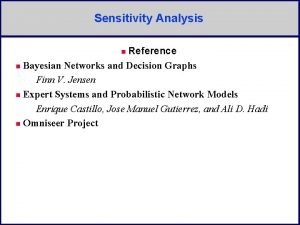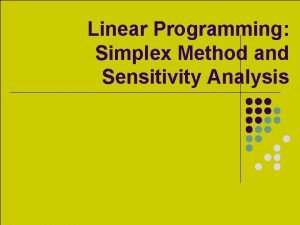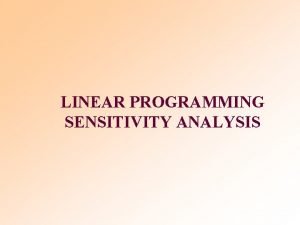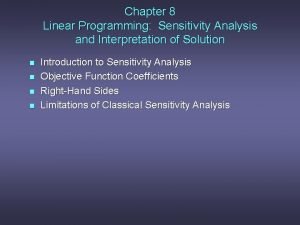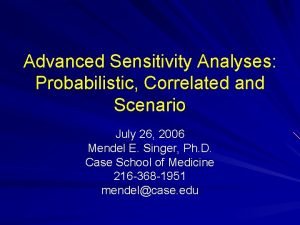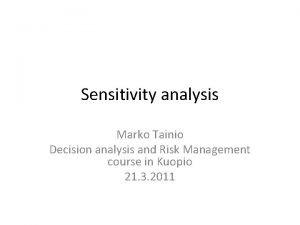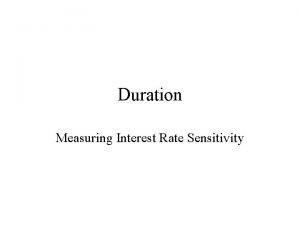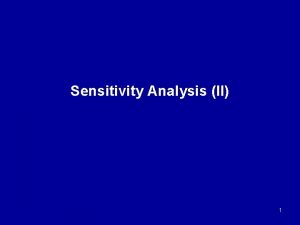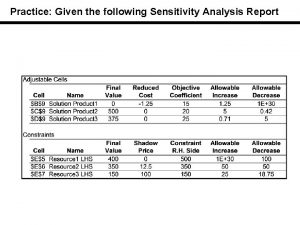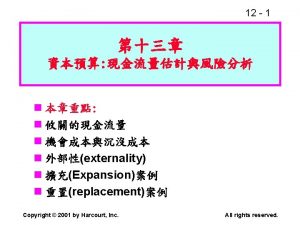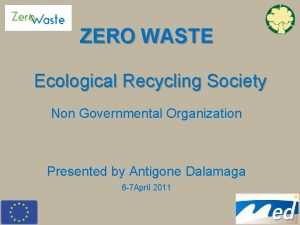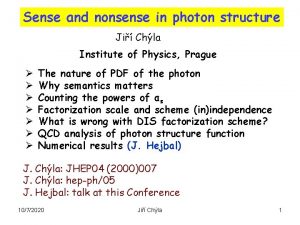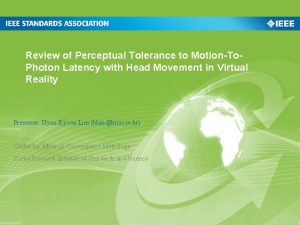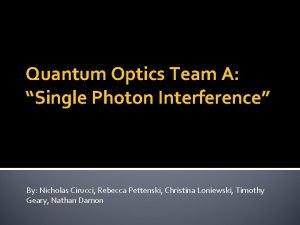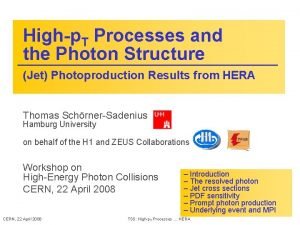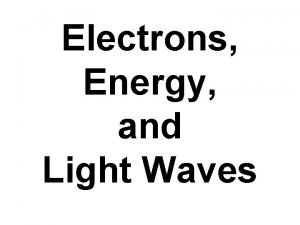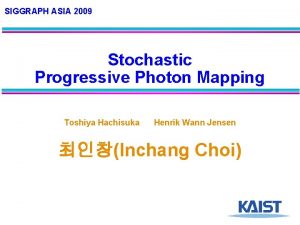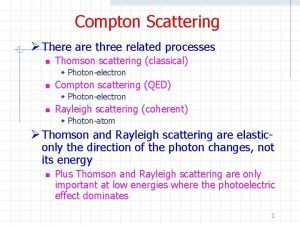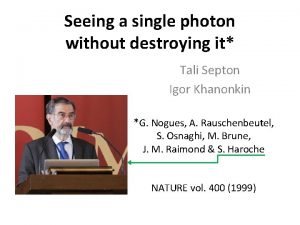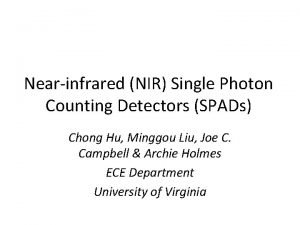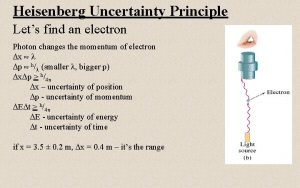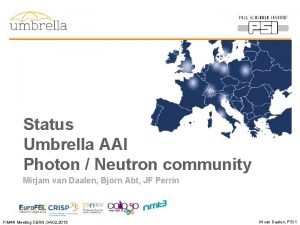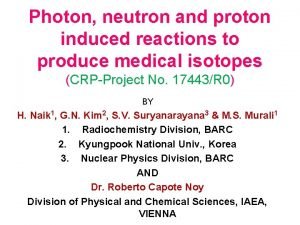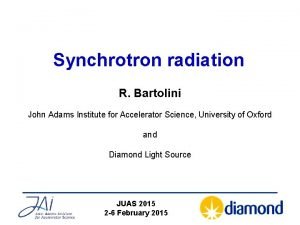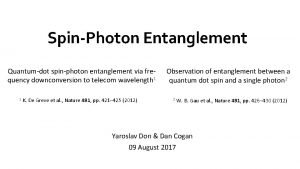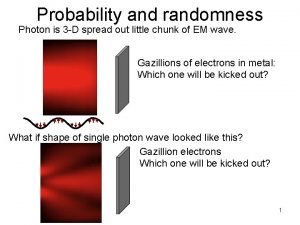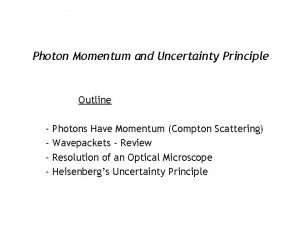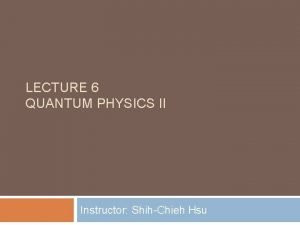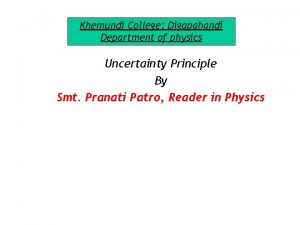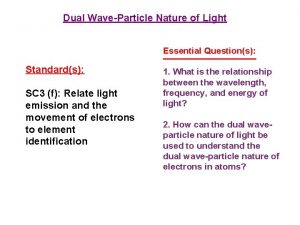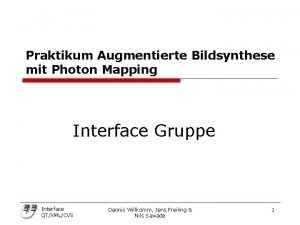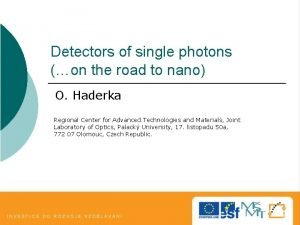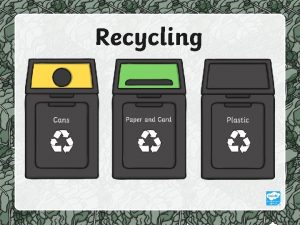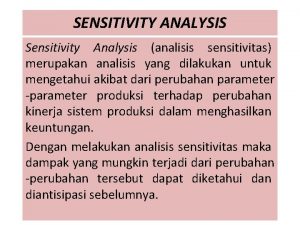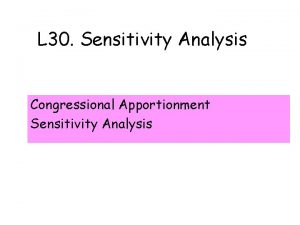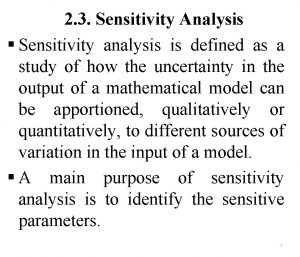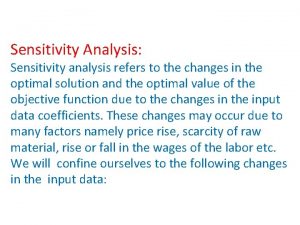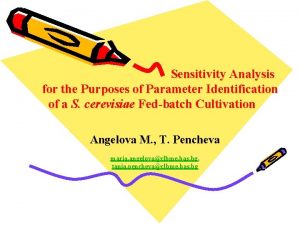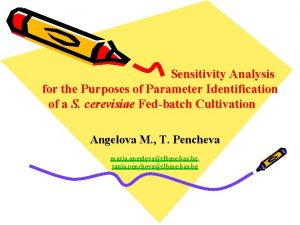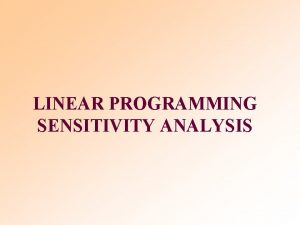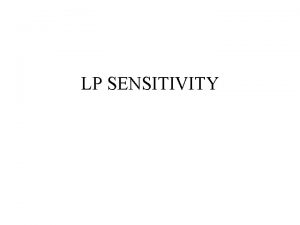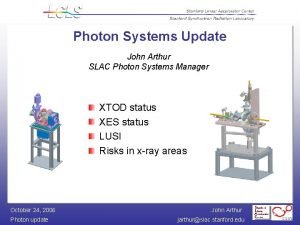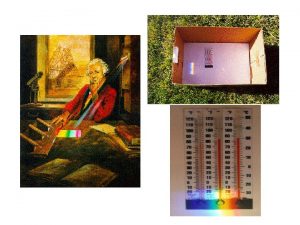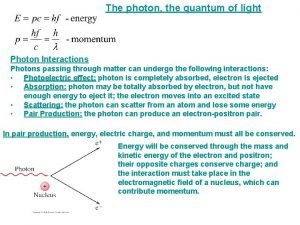PARAMETER SENSITIVITY ANALYSIS OF PHOTON RECYCLING IN GALIUM



















































- Slides: 51

PARAMETER SENSITIVITY ANALYSIS OF PHOTON RECYCLING IN GALIUM ARSENIDE SOLAR CELLS: METHODOLOGICAL DEVELOPMENT GRACE CAREY, ILYA KORSUNSKY, ARJUNEN KUTAYIAH, KATHLEEN MCGOVERN, LAUREN SWADDELL

Outline • • Motivation: Environmental Impact Solar Cells: Behind the Physics Modeling and Optimization Sensitivity Analysis (PLS regression) Implementation Results Design Conclusions Future Directions


U. S. Energy Consumption and Production predictions Source: U. S. Energy Information Administration, Annual Energy Outlook 2011, Early Release, December 16, 2011.

U. S. energy consumption in 2009

U. S. Primary Energy Flow

Source: U. S. Department of Energy, Department of Fossil Fuels, 2011

Carbon Dioxide Emissions


Ice Core Data and The Keeling Curve

Vostok Ice-Core Data

Alternatives to fossil fuels? The suspense is terrible… I hope it’ll last

Nuclear Energy • • 400 nuclear plants in the world 100 nuclear plants in the US alone Powers ~15% of US energy needs Relies on the use of uranium and other fissible materials to generate electricity • • Uranium is a finite mineral resource Cooling methods often employ the use of local water systems endangering aquatic life Nuclear power plants in the US produce 2000 metric tons of radioactive waste Nuclear disasters can emit large amounts of radiation which can be lethal and detrimental to the environment • •

Solar Energy • • Sustainable and renewable resource which does not emit greenhouse gases ~1% of U. S. energy Solar energy hitting the earth is approximately 274 million gigawatt/year = 8. 2 million quads of Btu/year Solar cells currently have an average efficiency of 15% 369 thousand quads of Btu/year can be collected if all land mass of earth had solar panels Total potential for solar energy is 444, 000 TWh The world’s total energy consumption is 132, 000 TWh The total annual energy consumption in the US is less than 0. 5% theoretical amount of sunlight received

Solar Cell Efficiency Tables

Solar Cell Efficiency Tables

Solar Cell Efficiency Tables

Solar Cell Efficiency Tables

Outline • • Motivation: Environmental Impact Solar Cells: Behind the Physics Modeling and Optimization Sensitivity Analysis (PLS regression) Implementation Results Design Conclusions Future Directions

N type Contacts P type N type Electric field Space Charged Region Photon P type N type P type

Radiative Recombination Conducing Band, Ec Band Gap, Eg = Ec - Ev Valence Band, Ev

Photon Recycling • Re-absorption of photons generated in a semiconductor device as a product of radiative recombinations. • Increases efficiency by 1 -2% Ga. As • Semiconductor • Direct Band Gap • No energy is lost to phonons (lattice vibrations) as a result of radiative recombinations. • Good for optical devices

Outline • • Motivation: Environmental Impact Solar Cells: Behind the Physics Modeling and Optimization Sensitivity Analysis (PLS regression) Implementation Results Design Conclusions Future Directions

Modeling: Motivation • Goal: create the best solar cell we can! – Efficacy – Cost – Environmental Impact • Need some design guidelines • Computational model handles complexity

The Model

The Model • Output: Photon Recycling Rate • Inputs: – – – – – Temperature Front Surface Reflection Width Angle of Incidence Refractive index Light Wavelength Internal Surface Reflectance of Metal Grid Front Internal Shadow Factor

How do we use the model? • Optimize Photon Recycling over the input parameters

Dealing with Complexity • 9 input parameters => 9 dimensional hypercube • Are all the parameters important? • Sensitivity analysis gives importance of each parameter • Cut down search space

Outline • • Motivation: Environmental Impact Solar Cells: Behind the Physics Modeling and Optimization Sensitivity Analysis (PLS regression) Implementation Results Design Conclusions Future Directions

The simplest and most powerful relationship between independent and dependent variables is linear. The dependent variable can be predicted from the independent variable by fitting the data to as follows:

The problem is almost always more complicated. If the dependent variable is a function of multiple independent variables, we have: This describes multilinear dependencies for only one sample; for n samples y can be written as a column vector and the values of x form the rows of matrix X:

In multiple linear regression, the solution for the b vector take the form: Can anyone see a potential problem here? The formula for b depends on the invertability of the product matrix of the X row vector and the X matrix!

Partial least squares (PLS) regression does not depend on the invertability of input data. Assume a linear relationship between independent parameter matrix X and dependent output matrix Y: PLS regression uses a variation of the NIPALS algorithm to find the best approximation of this linear relationship in the form of regression matrix, B.

What does the PLS algorithm look like?

The Model

The previous complexity can be reduced to the following:

The regression coefficients (Bpls) can give us the following information: (1) Significance of independent parameters to output(s) of interest (2) Prediction of dependent parameters from independent parameters (unlike PCA) (3) Indication of parameters to be tested in future experiments (4) Unreasonable results indicate that a mathematical model needs to be reevaluated in some regard

Outline • • Motivation: Environmental Impact Solar Cells: Behind the Physics Modeling and Optimization Sensitivity Analysis (PLS regression) Implementation Results Design Conclusions Future Directions

The Model

Photon recycling rate (GPR): function map KEY GPR (x) = 2π ∫d E ∫ dμ α b(E, x, μ) = { 2αw Φ= exp μ ΨOF = RR ΨOR = RF ∫ ∫ α + μ exp α - μ exp - R F RR αx' bn exp μ ( α x' bn exp μ ( ∞ 1 EG -1 ( -αx μ b(E, x, μ) )x [ RF Φ ΨOF + )x [ RR Φ ΨOR + bn(E, x) = )dx’ + exp( 2 h 3 c 2 2αw μ )dx’ +∫ b exp( n Experimental variables Constants Functions ∞ ∫b 0 n exp w ∫b x n exp ( α x' μ )dx’ ] if 1 ≤ μ < 0 ( α x' μ ) dx’ ] if 0 > μ ≥ -1 ˆn 2 E -qφ(x) ( k. T ) - 1 )∫ b exp( n - α x’ μ ) dx’ α= - α x’ μ ) dx’ 4 log(10) π κ λ μ = cosθ E= h*c λ RF = κF * FSF + ρF * (1 – FSF)

Photon recycling rate (GPR): function dependency chart GPR E α Φ RF μ RF b μ bn E α μ α ΨOF ΨOR RF bn bn E E

Photon recycling rate (GPR): code sample

Outline • • Motivation: Environmental Impact Solar Cells: Behind the Physics Modeling and Optimization Sensitivity Analysis (PLS regression) Implementation Results Design Conclusions Future Directions

We can apply the PLS algorithm to our input and output data. Input Trials Output 1. 5 0 Parameters T ha t n q W SF F r F k l k -1. 5 GPR

Results of PLS regression: BPLS Input Matrix Output k 1. 5 l k. F *F r = SF 0 W q nhat -1. 5 T ha t n q W SF F r F k l k T GPR

Results of PLS Regression: GPR Regression Coefficients 1 These give quantitative insight into how changing input parameters affects output. 0. 5 0 Significant parameters include wavelength of light, temperature, and the front reflectance. -0. 5 T ha t n q W SF F r F k l k -1

Accuracy of regression

Conclusions: 1. PLS regression is an accurate tool for both determining parameter sensitivities from our simulated data sets and predicting the output variable data of interest. 2. As conserving energy is of optimal interest to the environment, photon recycling is an important physical phenomenon to energy conservation and solar cell efficiency. 3. From our regression analysis, the parameters which should be maximized in future cell design are wavelength of light directed at the solar cell, temperature, and front reflectance.

Future Directions • Function for cost • Function for environmental impact • Convex optimization

Questions • Any? • No? • Thanks!

Acknowledgements • • The Catalyst Scholarship Program! Dr. Haydee Salmun All of our wonderful advisors Dr. Eric Sobie and Amrita Sarkar
 Contoh dari isoelektron
Contoh dari isoelektron Dcf sensitivity analysis
Dcf sensitivity analysis Decision models
Decision models Sensitivity analysis bayesian network
Sensitivity analysis bayesian network Simplex method and sensitivity analysis
Simplex method and sensitivity analysis Solver shadow price
Solver shadow price Sensitivity analysis and duality
Sensitivity analysis and duality Cap rate sensitivity analysis
Cap rate sensitivity analysis Sensitivity analysis and interpretation of solution
Sensitivity analysis and interpretation of solution Advanced sensitivity analysis
Advanced sensitivity analysis Marko tainio
Marko tainio Sensitivity analysis lecture notes
Sensitivity analysis lecture notes Interest rate sensitivity analysis
Interest rate sensitivity analysis Profit sensitivity analysis
Profit sensitivity analysis Psioptparam
Psioptparam Sensitivity analysis
Sensitivity analysis Cvp sensitivity analysis
Cvp sensitivity analysis Scenario analysis 中文
Scenario analysis 中文 Interest rate risk sensitivity analysis
Interest rate risk sensitivity analysis Swot analysis of plastic recycling company
Swot analysis of plastic recycling company Photon structure
Photon structure Motion-to-photon latency
Motion-to-photon latency Hertz units
Hertz units Photon
Photon Photon is our business
Photon is our business Photon structure
Photon structure Energy planck's constant
Energy planck's constant Electron vs photon
Electron vs photon Assay technology inc
Assay technology inc Desy photon science
Desy photon science Stochastic progressive photon mapping
Stochastic progressive photon mapping Lepton-photon
Lepton-photon Photoelectric and compton effect
Photoelectric and compton effect Single photon
Single photon Single photon
Single photon Photon uncertainty principle
Photon uncertainty principle Photon neutron
Photon neutron Photon neutron
Photon neutron Photon neutron
Photon neutron Dis off
Dis off Photon polarization
Photon polarization Momentum of a photon
Momentum of a photon Synchrotron radiation
Synchrotron radiation Photon polarization
Photon polarization A photon checks into a hotel
A photon checks into a hotel Photon chunk
Photon chunk Do photons have momentum
Do photons have momentum Jj thomson
Jj thomson Momentum of photon formula
Momentum of photon formula Photon
Photon Photon mapping c++
Photon mapping c++ Gianluca verona rinati
Gianluca verona rinati



